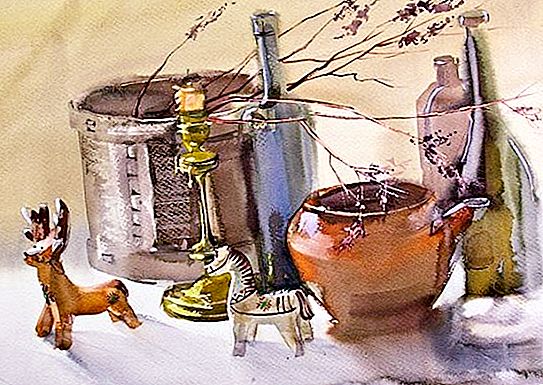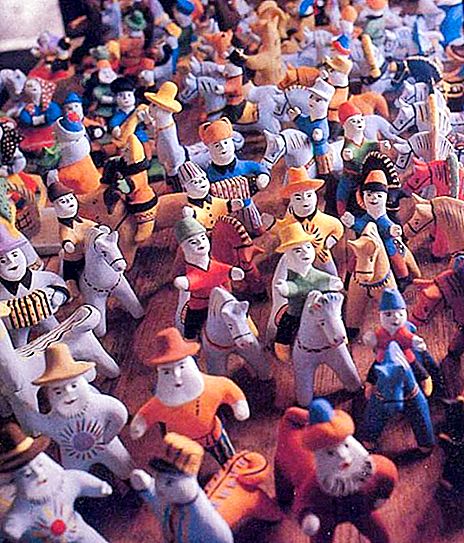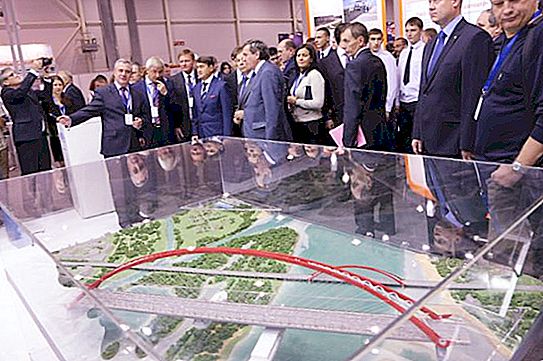In the villages that were located on the territory of the Kargopol district (today it is the Kargopol district of the Arkhangelsk region), from ancient times, they were engaged in the creation of pottery household items. This business was seasonal - when agricultural work was completed, the peasants could afford to do potting. Different crafts were made from clay waste. So the famous Kargopol toy appeared. Initially, no one took this craft seriously. For coloring products used improvised materials. Basically this was furnace black and lime.
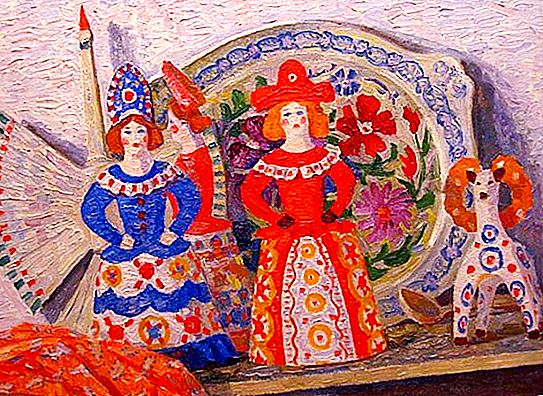
What is a clay toy?
Clay Kargopol toys are figures in the form of dogs, bears, fairy-tale heroes, squat men with beard-shovels, women with newborn babies, birds and other living creatures. Despite such a wide variety of forms, the ancient Kargopol clay toy did not have a bright color, because chalk, soot and colored clay were used as paints. A modern little thing is already distinguished by brighter shades, but professionals try not to make their creations very colorful. Red, blue, green, white, black and ocher are the most popular shades for painting products.
Most toys are characterized by mural elements such as crosses, red big circles, rings. All these are ancient solar symbols. Also used were motifs of plant petals, ears of bread and grains.
Authorship

In most cases, the names of the manufacturers of such gizmos are not known to anyone. But there are some famous masters of the Kargopol toy, thanks to whose work the craft was saved and characteristic elements were brought into it.
In the thirties of the last century, Ivan Vasilievich Druzhinin, a descendant of the potters' family, lived in the village of Grinevo. He was one of the most talented creators of clay toys. Today, people know his masterpieces as classic Kargopol.
Grinevo became the birthplace of another famous craftswoman, from whose hands appeared a wonderful Kargopol toy. Her name is Uliana Babkina. Starting to create toys at the age of 15, Babkina continued her craft until the end of her life. It was she who did not let the beautiful custom work of souvenirs end. This Ulyana Ivanovna saved the image of a horse-polkan, or, as it is also called, a polykhan. A centaur with a beard, which is Polkan - one of the most beloved and sought-after images of the Kargopol clay toy.
Shevelev Dynasty
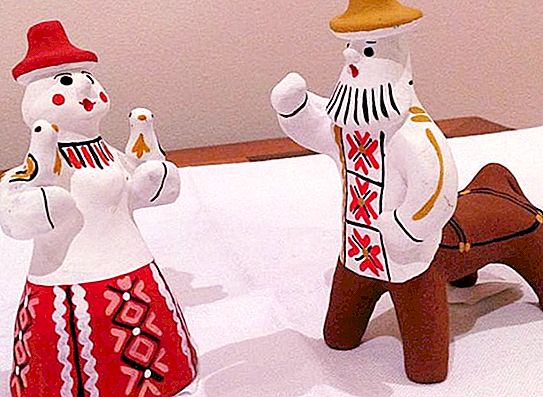
The toy from Kargopol owes much of its development to Shevelev. It is impossible to talk about amazing gizmos without mentioning these glorious people. The Shevelevs clan originates in the village of Tokarevo, which was a couple of kilometers from Kargopol itself along the Pudozhsky tract. Shevelev Alexander Petrovich gave life to the branch of the Kargopol branch of the "White Sea Patterns", which produced toys.
Today, the business of the ancestors was inherited by Valentin Dmitrievich Shevelev. He is engaged in the reconstruction of an ancient technique for welding crafts, which involves placing a toy heated after firing in a so-called bump - a thick solution based on flour. As a result, the surface of the product is covered with decorative stains and black spots. All this is possible thanks to burnt flour. In Kargopol in 2003, the House-Museum of the Shevelev dynasty and the Kargopol clay toy was created.
Woman
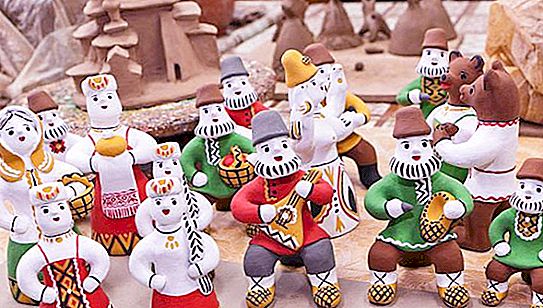
The oldest Kargopol toy is a woman. Due to the combination of rather ancient elements and its archaic character, it relates the user to the Mesolithic, Neolithic and Paleolithic eras. In appearance, the figure resembles a woman-idol, made of stone, with a straight, flat face. Historians believe that she personifies the Great Mother, who, presumably, refers to the matriarchy of the Paleolithic period. She later reincarnated as a symbol of Mother Earth, the main goddess of Nature. After some time, the cult value of the toy was lost, and it became just a child’s fun and accessory of the peasant.
Woman Production
The figure is molded in separate parts: head and torso, hands, bell skirt and headgear. The body and skirt were attached to each other, squeezed both hands-sausages, twisted them in the shape of a fist and also fixed. The headdress in the form of a kokoshnik or hat was attached to the very latest. This ended the modeling.
The Kargopol toy further needed to be painted. The woman was subjected to lime treatment; sometimes a solution based on chalk and milk was used for this purpose. Then the masters set about drawing the apron. It was filled with a variety of images of symbolic meaning. So, wave-like lines symbolized water and rain, zigzags meant lightning, showers and thunderstorms. The image of the cross in the circle symbolized the sun, and the cross in the rhombus symbolized the earth. The painting of the Kargopol toy in the form of a cross with dots meant a sown field, and various curls are sprouts. Generally speaking, all the symbols described above were related to a settled resident, a plowman or a sower.
Polkan
A special place in the history of clay crafts is occupied by the Kargopol toy Polkan. Specialists in the field of creating souvenirs believe that the word "polkan" comes from "polkony". This toy appeared after the woman. It is considered as curious and archaic, contains many different meanings. Polkan is a centaur, a horse man who wore a beard and a hat. Sometimes he was portrayed with a woman's chest. In Polykhan a very important symbol of the peasantry appears - a horse. He became the embodiment of tillage, wealth, nobility and strength.
Polkan is a farmer, since the first plowmen were perceived precisely as “horse people”. A beard is evidence of adulthood, and a broad chest is a symbol of the prime of life. What does the female breast symbolize? The history of the Kargopol toy says that it is a universal symbol of peasants: the patron of the clan, family, master, keeper of the hearth.
Other figures
Other ancient images include images of animals. At first, hares were popular, a little later they were replaced by horses. A special place of honor was occupied by a bear (“bear”) with or without offspring. She could be sculpted with a variety of household items, for example, with a fish or a mirror in her paws. A bear is one of the first symbols of the planet.
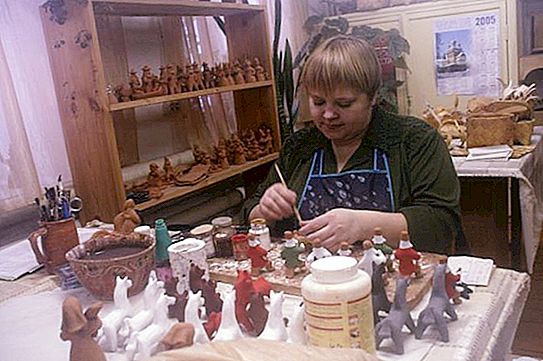
The latest plots of the Kargopol clay toy include images related to rural life. So, the craftsmen sculpted a trio of harnessed horses with riders. Men with long beards, holding a accordion, bast shoes or pipe, peasant women and mistresses - all these are prototypes of clay crafts.
Features of Kargopol toys
Kargopol clay toy has a rather archaic appearance. She has a recognizable style, types and painting. This little thing can truly be called folk, as its performance is as free as possible. Conventionally, all the plots of crafts can be divided into several categories: the first includes archaic types, such as Bereginya - a woman who holds pigeons in her hands, as well as horses, Polkan and other animals. The second type of Kargopol toys includes plot items that demonstrate scenes from rural life. This category of souvenirs also illustrates stories from fairy tales. This may include such compositions as “Girl at the Laundry”, “Turnip” and others.
The Kargopol toy of traditional painting is a bleached craft painted with different colors, but without applying unnecessary details and unnecessary gloss. Despite the fact that the figure has bright shades, it looks muffled. The person signs rather conditionally.
About the Kargopol toy today
Today, in addition to classical images, multi-figure compositions have gained wide popularity. Here there is movement and character, the masters have a desire to do everything as in real life. Potters set plots and themes. For the most part, this is the life of peasants, their holidays and weekdays. A great variety of new subjects is being developed that are related to holiday dates, to various exhibitions, events that take place in a particular city.
Shevelev House Museum
Kargopol, Gagarina street, house number 30 - it is in this old log building with green platbands that the Shevelev House Museum known throughout Russia is located. This is the family nest of the dynasty of famous masters of Kargopol toy. There are two small rooms in which Klavdia Petrovna and Dmitry Vasilievich Shevelev lived at one time. They raised three children - Valentine, Vladimir and Vitaly. And they gave life to their children, who do not give the abyss to the craft of their ancestors. When Dmitry Vasilievich died at the end of 2000, his heirs proposed opening a museum. This idea was supported by the district administration, and two years later the authorities gave the second half of the premises for rent to the Shevelevs.


